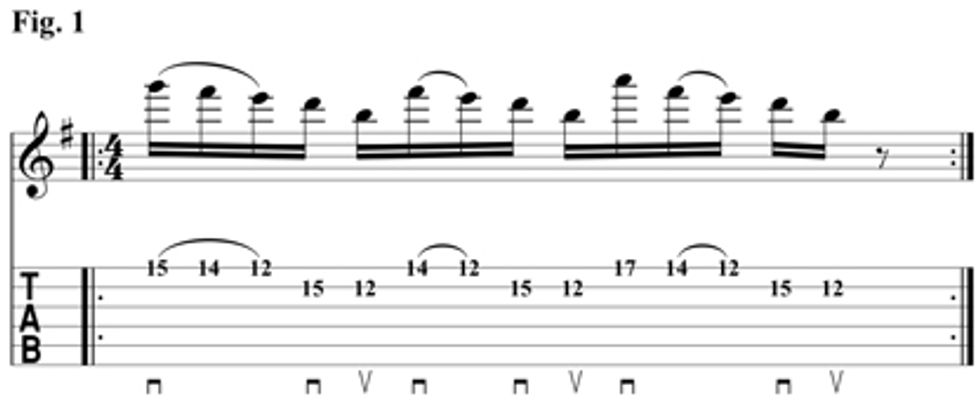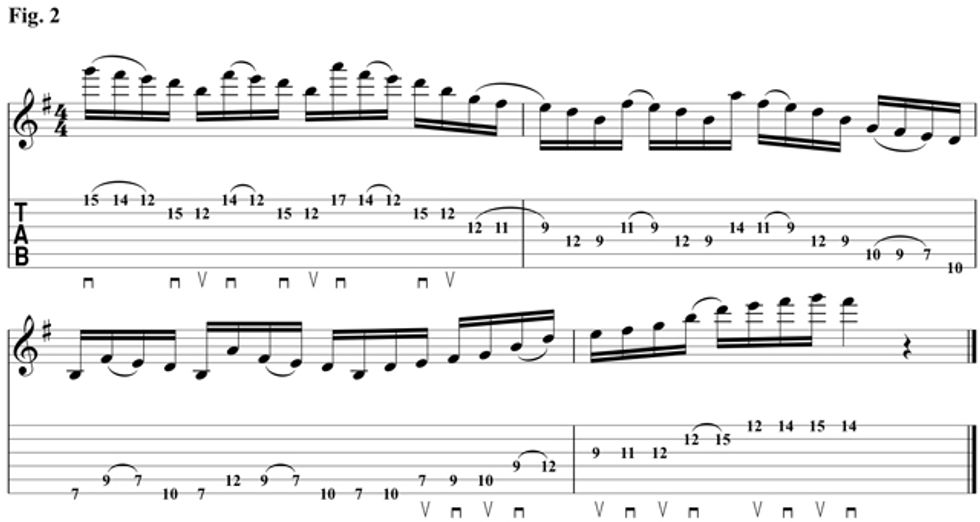If one had to choose the best “one, two, three, four” in all of recorded music, who would get the prize?
Chops: Intermediate
Theory: Intermediate
Lesson Overview:
• Learn how to play guitar and
count to four at the same time.
• Feel the rush of an Em9
arpeggio.
• Create long phrases by combining
odd-numbered lines in
different octaves.
Click here to download sound clips from this lesson's notation.
If one had to choose the best “one, two, three, four” in all of recorded music, who would get the prize? Among the songs I’m familiar with, it would have to be a three-way tie between Paul McCartney’s spirited count at the start of The Beatles’ “I Saw Her Standing There,” the passionate shout before the last verse of “Born to Run” by Bruce Springsteen, and George Harrison’s grumble at the top of The Beatles’ “Taxman.” The Ramones get honorable mention for their legendary live four-counts, but when I actually listened to the studio recording of “Sheena is a Punk Rocker,” it was either a “Go” or a “Four.” (I’m guessing that the mastering engineer chopped off the “one, two, three.”) There must certainly be other greats in this category, but those are the first that came to my mind.
My challenge for you this month is to play guitar and count to four at the same time.
Fig. 1 is the phrase I want to use. It can be played over an Em chord or an Em9 chord for more flavor.

There are 14 notes here. But I look at it as “5–4–5.” That is: five notes descending, then four notes descending, then five notes descending. I visualize these three sets of notes separately, and it makes the larger phrase easier to hold in my brain.
I like to use a combination of picked notes and pull-offs. Please check out my suggested combination. The pull-offs allow me to “recalibrate” my picking pattern so that each of the three sets can begin with a downstroke. This helps me to mentally keep them organized, and I think that it’s physically easier to play too.
After you’ve practiced this enough to make it comfortable, it’s time to repeat it in two lower octaves, as you can see in Fig. 2. This is relatively easy to do. The notes are the same (just octaves lower), the fingering pattern is the same, and the picking/pull-off pattern is the same. All you have to do is shift positions and move to a lower set of strings.

Rhythmically, I removed the eighth-note rest that ended the bar in Fig. 1. So now, the high set of 14 notes leads right into the middle set of 14 notes … which leads right into the bottom set of 14 notes.
As they go whooshing by, these “14s” create an interesting rhythmic disorientation for the listener. But I want us (the players) to remain in rhythmic control. Somebody should know where “one” is, and it might as well be us.
The first step to accomplish this is to master the phrase itself. I should mention that after the three “14s,” we go straight up an Em9 arpeggio to resolve the phrase. These are challenging licks, so I hope that the combinations of picking, pull-offs, and hammer-ons will make them easier to play. Once you’ve emerged from the woodshed with mastery of the entire phrase, it’s time to start counting!
It will take some time and practice to develop the coordination to juggle these phrases accurately. But it is possible. And it’s actually quite thrilling to get it right. It can feel surprisingly like looking down from the top floor of a skyscraper, or looking over the edge of a famous canyon.
I’m really scared of bungee jumping, but playing this phrase while counting “one, two, three, four” gives me a palpable rush. Why bungee jump, when you can play Em9 phrases and count to four?
Or try both and compare.
May all your canyons be grand.



